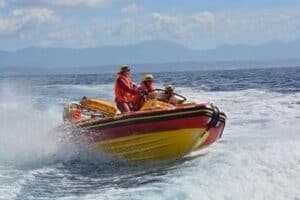An industrial survey has been completed by the municipality and will start taking samples to test for hydrocarbons seemingly ending up in the Knysna estuary.

Knysna authorities are investigating sources of oil and grease polluting storm water drains in a popular area close to the Knysna CBD.
Nandi Mgwadlamba from SanParks explained that this eventually causes problems for waste water treatment in the area.
The Garden Route District Municipality has since asked surrounding restaurants to prove how they dispose of their oil and grease.
“Letters requesting restaurants to provide proof of their oil and fat disposal mechanisms were completed.
“Recent oil and grease tests show a drastic decrease in level at the municipality’s Waste Water Treatment Works (WWTW),” Mgwadlamba said.
The municipality has also removed residual oil and grease in sumps which has led to the recovery of the WWTW.
“The District’s inspections of which sumps link to restaurants are also ongoing,” Mgwadlamba said.
An industrial survey has been completed by the Knysna Municipality and will start taking samples to test for hydrocarbons seemingly ending up in the Knysna estuary.
“The Knysna Municipality tests for oil and grease more regularly subsequent to an incident of an influx of oil and grease in February 2019 which caused a problem at the Waste Water Treatment Works (WWTW).
“This is aimed at narrowing down sources of pollution,” Mgwadlamba said.
She added that the water is tested for more than just E-Coli, but also nutrients in the WWTW effluent including ammonia, PH level, nitrates, suspended solids and chlorine.
“Of the fifteen sites monitored, four have a history of non-compliance including the Bongani channel, Long Street, and the Train Station culverts, which are still non-compliant.
“This means that the areas of the Ashmead Channel around Cathy Park and Loerie Park as well as the area around the Long Street culvert are not safe for recreational use,” Mgwadlamba said.
Warning signs have been put up until these areas can be used safely.
On the other hand, recreational areas around the estuary and SANParks’ such as Green Hole, Bollard Bay, Knysna Waterfront, Brenton, The Heads, Costa Sarda and Belvidere have lower E-Coli counts and are safe to use.
Efforts to prevent solid waste getting into the estuary have been boosted by the appointment of seven teams to assist with this.
“Five of the seven Working for the Coast teams have begun work already collecting waste at beaches, culverts and around the estuary.”
But there are still “alarming” amounts of litter that has since been collected in just three days.
227 black of litter and 104 bags of recyclable material have been collected by the teams.
Residents have been urged to “take responsibility for their own litter to avoid negative impacts on the animals and plants in the estuary and the tourism attractions in Knysna”.
Extra litter collection facilities have been installed by the municipality while teams have been tasked with cleaning up recreational areas.
“The Municipality has also encouraged residents to report blockages in manholes to the Municipality’s hotline number 044 302 6331 (office hours) and also an app (knysna.comunity.me),” Mgwadlamba said.
For more news your way, download The Citizen’s app for iOS and Android.






